Justicia (plant)
| Justicia | |
|---|---|
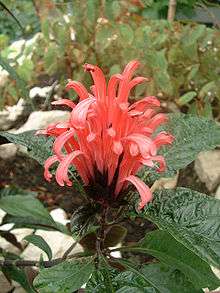 | |
| Justicia magnifica | |
| Scientific classification | |
| Kingdom: | Plantae |
| Clade: | Angiosperms |
| Clade: | Eudicots |
| Clade: | Asterids |
| Order: | Lamiales |
| Family: | Acanthaceae |
| Subfamily: | Acanthoideae |
| Tribe: | Justicieae |
| Genus: | Justicia L.[1] |
| Species | |
|
See text | |
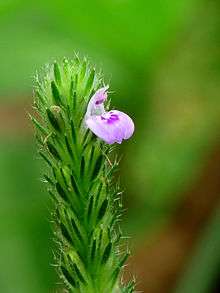
Justicia is a genus of flowering plants in the Acanthaceae family. It is the largest genus within the family, encompassing around 700[2] species with hundreds more as yet unresolved.[3] They are native to tropical to warm temperate regions of the Americas, India and Africa. The genus serves as host to many butterfly species, such as Anartia fatima. Common names include water-willow and shrimp plant, the latter from the inflorescences, which resemble a shrimp in some species. The generic name honours Scottish horticulturist James Justice (1698–1763).[4] They are closely related to Pachystachys.[5]
Description
They are evergreen perennials and shrubs with leaves which are often strongly veined; but they are primarily cultivated for their showy tubular flowers in shades of white, cream, yellow, orange or pink. They are not hardy below 7 °C (45 °F), so may be grown under glass in frost-prone areas.[5]
Selected species
- Justicia adhatoda L.
- Justicia adhatodoides (E.Mey. ex Nees) V.A.W.Graham
- Justicia alexandri R.Atkinson
- Justicia americana L.
- Justicia androsaemifolia (Nees) Lindau
- Justicia angusta (Chapman) Small
- Justicia angustifolia Nees
- Justicia austroguangxiensis H.S.Lo & D.Fang
- Justicia betonica L.
- Justicia borinquensis
- Justicia brandegeeana Wassh. & L.B.Sm.
- Justicia brasiliana Roth
- Justicia burchellii Hiern
- Justicia californica (Benth.) D.N.Gibson
- Justicia camerunensis (Heine) B.J.Pollard
- Justicia candicans (Nees) L.Benson
- Justicia carnea Lindl.
- Justicia carthagenensis Jacq.
- Justicia chrysotrichoma Pohl ex (Ness)
- Justicia clausseniana Nees Profice
- Justicia comata (L.) Lam.
- Justicia cooleyi Monachino & Leonard
- Justicia crassifolia (Chapman) Chapman ex Small
- Justicia culebritae Urban
- Justicia cydoniifolia
- Justicia cynea Leonard
- Justicia diffusa
- Justicia flaviflora (Turrill) Wassh.
- Justicia fulvicoma
- Justicia galapagana Lindau
- Justicia gendarussa
- Justicia genistiformis Nees
- Justicia heterocarpa
- Justicia hyssopifolia
- Justicia ianthina Wassh.
- Justicia irwinii Wassh.
- Justicia japonica Thunb.
- Justicia kotschyi
- Justicia lanstyakii Rizzini
- Justicia leonardii
- Justicia leucoxiphos Vollesen et al. in prep.
- Justicia longii Hilsenb.
- Justicia martinsoniana Howard
- Justicia mirabiloides Lam.
- Justicia nervata (Lindau) Profice
- Justicia nodicaulis Nees
- Justicia nuriana Wassh.
- Justicia orbicularis (Lindau) V.A.W.Graham
- Justicia orchioides (Walt.) Lindau
- Justicia ovata
- Justicia pectoralis Jacq.
- Justicia petiolaris (Nees) T.Anders.
- Justicia peploides
- Justicia procumbens
- Justicia plumbaginifolia J.Jacq
- Justicia polita Nees Profice
- Justicia procumbens
- Justicia pubigera
- Justicia pycnophylla Lindau
- Justicia quinqueangularis
- Justicia rigida Balf.f.
- Justicia riopalenquensis Wassh.
- Justicia riparia C.Kameyama
- Justicia rizzinii Wassh.
- Justicia runyonii Small
- Justicia sarithroides Lindau
- Justicia secunda Vahl
- Justicia serrana C.Kameyama
- Justicia sonorae Wassh.
- Justicia sphaerosperma
- Justicia spicigera Schltdl.
- Justicia stearnii V.A.W.Graham
- Justicia takhinensis R.Atkinson
- Justicia tinctoria
- Justicia tobagensis (Urb.) Wassh.
- Justicia tocantina (Nees) V.A.W.Graham
- Justicia tweediana
- Justicia umbrosa Benth.
- Justicia vahlii
- Justicia ventricosa
- Justicia warmingii Hiern
- Justicia warnockii B.L.Turner
- Justicia wrightii A.Gray[6]
Justicia americana (American water-willow), is native to eastern North America north to southern Ontario; it is the hardiest species in the genus, hardy to USDA Plant Zone 4. Justicia ovata (looseflower water-willow) occurs nearly as far north, reaching Michigan.
Justicia brandegeeana (formerly Beloperone guttata, commonly called shrimp plant) is native to Mexico. It is hardy to −4 °C but will often recover in the spring after freezing back in USDA Plant Zone 8a.
Justicia carnea (formerly Jacobinia carnea, common names including Brazilian plume flower, flamingo flower, and jacobinia) is native to South America in southern Brazil, Paraguay and northern Argentina. It is hardy to −2 °C but will often recover in the spring after freezing back in USDA Plant Zone 8a.
Justicia procumbens is procumbent herb with angular stems, swollen at nodes, small ovate leaves, small purple flowers in terminal spikes, inserted didynamous stamens, and shortly bilobed stigmas.
Synonyms
Genera which have been brought into Synonymy with Justicia include Acelica, Adhatoda, Amphiscopia, Anisostachya, Aulojusticia, Averia, Beloperone, Calliaspidia, Calymmostachya, Chaetothylopsis, Chiloglossa, Cyphisia, Cyrtanthera, Cyrtantherella, Dianthera, Dimanisa, Drejerella, Duvernoia, Emularia, Ethesia, Glosarithys, Harnieria, Heinzelia, Hemichoriste, Heteraspidia, Ixtlania, Jacobinia, Kuestera, Libonia, Lophothecium, Lustrinia, Nicoteba, Orthotactus, Parajusticia, Petalanthera, Plagiacanthus, Plegmatolemma, Porphyrocoma, Psacadocalymma, Rhacodiscus, Rhiphidosperma, Rhyticalymma, Rodatia, Rostellaria, Rostellularia, Saglorithys, Salviacanthus, Sarotheca, Sericographis, Simonisia, Solenochasma, Stethoma, Tabascina, Thalestris, Thamnojusticia, and Tyloglossa.[7]
Gallery
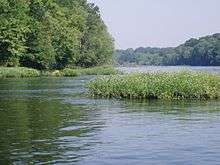 Typical habitat of American Water-willow (Justicia americana) on the Coosa River near Wetumpka, Alabama
Typical habitat of American Water-willow (Justicia americana) on the Coosa River near Wetumpka, Alabama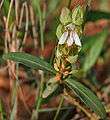
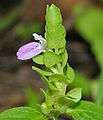 Justicia glauca in Hyderabad, India.
Justicia glauca in Hyderabad, India.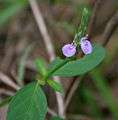 Justicia procumbens var. simplex near Talakona forest, in Chittoor District of Andhra Pradesh, India.
Justicia procumbens var. simplex near Talakona forest, in Chittoor District of Andhra Pradesh, India.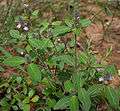



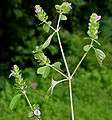 Justicia glauca in Hyderabad, India.
Justicia glauca in Hyderabad, India.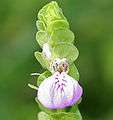 Justicia glauca in Hyderabad, India.
Justicia glauca in Hyderabad, India.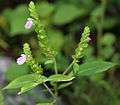 Justicia glauca in Hyderabad, India.
Justicia glauca in Hyderabad, India.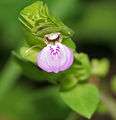 Justicia glauca in Hyderabad, India.
Justicia glauca in Hyderabad, India.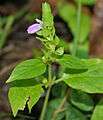 Justicia glauca in Hyderabad, India.
Justicia glauca in Hyderabad, India.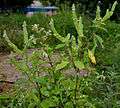 Justicia glauca in Hyderabad, India.
Justicia glauca in Hyderabad, India.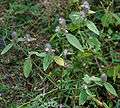
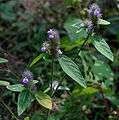
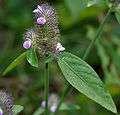

References
- ↑ "Genus: Justicia L." Germplasm Resources Information Network. United States Department of Agriculture. 2009-01-23. Retrieved 2010-05-26.
- ↑ Daniel, Thomas F. (2011). "JUSTICIA (ACANTHACEAE) IN TEXAS". Journal of the Botanical Research Institute of Texas. 5 (2): 595–618.
- ↑ http://www.theplantlist.org/1.1/browse/A/Acanthaceae/Justicia/
- ↑ Austin, Daniel F. (2004). Florida Ethnobotany. CRC Press. p. 381. ISBN 978-0-8493-2332-4.
- 1 2 RHS A-Z encyclopedia of garden plants. United Kingdom: Dorling Kindersley. 2008. p. 1136. ISBN 1405332964.
- ↑ "Justicia". Integrated Taxonomic Information System. Retrieved 2010-09-20.
- ↑ Plant Systematics: Justicia
External links
![]()
![]()
- Dressler, S.; Schmidt, M. & Zizka, G. (2014). "Justicia". African plants – a Photo Guide. Frankfurt/Main: Forschungsinstitut Senckenberg.